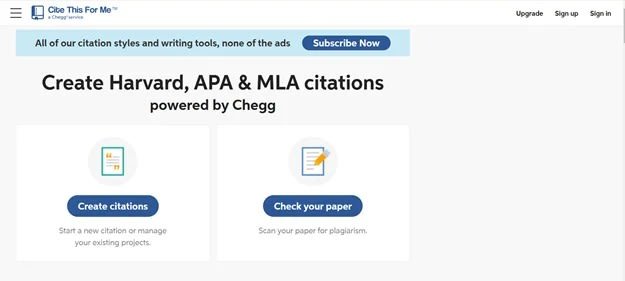AI Research
Perfect Citations Made Easy with AI Tools for Students and Researchers

Perfect Citations Made Easy for Students and Researchers
Citing sources accurately is a critical part of academic writing, whether you’re preparing an essay, thesis, research paper, or article. It ensures credibility, avoids plagiarism, and supports your arguments with evidence. However, manually creating citations can be time-consuming and confusing—especially when dealing with various citation styles. That’s where the Cite This For Me citation tool comes in. Designed for students and researchers, this AI-powered tool simplifies the entire referencing process and helps maintain academic integrity with ease.
With just a few clicks, users can generate citations in APA, MLA, Chicago, and other common styles, allowing them to focus more on content creation and less on formatting. It’s a modern solution that complements today’s fast-paced educational and professional environments.
Why Accurate Citations Matter
In academic and professional research, proper citations serve several essential purposes:
Acknowledging Original Work: Giving credit to the original authors and researchers.
Avoiding Plagiarism: Demonstrating ethical writing practices.
Supporting Your Claims: Providing reliable references to back up arguments or data.
Maintaining Consistency: Adhering to academic standards across different disciplines.
Despite its importance, citation formatting is often viewed as a tedious task, especially when juggling multiple sources and styles. This is where AI tools like Cite This For Me are transforming how students and researchers approach citations.
Streamlining the Process with AI
The Cite This For Me citation tool automates the citation process by allowing users to input source details (or even just a URL or book title), then generating a properly formatted citation in seconds. It reduces the risk of errors and ensures consistency across your bibliography or reference list.
Here’s how it works:
Choose a Citation Style: Select from popular styles like APA, MLA, or Chicago.
Enter Source Information: This could be a website, book, journal article, or more.
Generate the Citation: The AI formats your citation according to the chosen style.
Save and Organize: Compile multiple citations into a single document or bibliography list.
This convenience is particularly helpful for students managing multiple assignments or researchers working on large-scale projects.
Common Challenges in Manual Citation
Many students and professionals struggle with referencing due to:
Unfamiliarity with Formats: Each style has different rules for punctuation, order, and structure.
Time Constraints: Manually checking every source for accuracy is slow.
Inconsistency: Mixing formats leads to a disorganized final submission.
Stress and Confusion: Especially during final deadlines or long research projects.
AI tools eliminate these common problems by providing instant, reliable, and accurate citation support.
Role of AI Text Tools in Academic Writing
While citation tools are extremely useful, they often work best in combination with AI text tools. These tools assist in grammar checking, paraphrasing, summarizing, and organizing academic content.
AI text tools help in:
Improving Language Quality: Refining sentence structure, grammar, and clarity.
Enhancing Readability: Making academic writing more accessible and engaging.
Structuring Ideas: Suggesting outlines, headings, or transitions.
Summarizing Sources: Quickly extracting key ideas from articles and papers.
When used together with citation generators, AI text tools create a complete writing assistant suite for anyone involved in education or research.
Benefits for Different Types of Users
Let’s look at how AI-powered citation and writing tools help various users:
Students
Save time while writing assignments or theses.
Avoid accidental plagiarism with accurate source referencing.
Learn proper citation methods through visual examples.
Researchers
Manage long reference lists without losing track.
Focus on critical analysis instead of formatting.
Export citations directly into publishing platforms.
Teachers and Professors
Encourage ethical writing practices among students.
Review student citations easily.
Provide feedback with confidence.
Tools Like Cite This For Me Are Ideal For:
University Students: Especially in liberal arts, science, and research programs.
High School Students: Learning to write research papers and reports.
Academic Writers: Preparing journal articles, conference papers, or case studies.
Corporate Researchers: Creating white papers, reports, or internal documentation.
The growing integration of AI in the education sector is bridging gaps in knowledge and productivity. Tools that were once considered optional are quickly becoming essential.
How to Use Cite This For Me Effectively
To make the most of this citation tool:
Start Early: Input citations as you collect sources rather than at the end.
Double Check Sources: Ensure that the correct titles, URLs, and authors are input.
Save Your Work: Organize citations in folders or export them to your writing software.
Understand the Style: While the tool handles formatting, it’s helpful to learn the basics of citation styles used in your field.
This will ensure both accuracy and a better understanding of academic conventions.
The Future of Academic Writing with AI
As AI becomes more advanced, we can expect more integration between tools like Cite This For Me and other writing platforms. Future developments may include:
Voice Command Citation Creation
Real-Time Source Analysis
Smart Plagiarism Detection
Collaboration Tools for Group Projects
Such features will continue to reshape academic workflows and make citation and writing assistance more dynamic and accessible.
Conclusion
Creating perfect citations doesn’t have to be a frustrating task. Thanks to AI-powered tools like the Cite This For Me citation tool, students and researchers can now save time, reduce stress, and maintain academic excellence. When used alongside AI text tools, the entire research and writing process becomes more efficient and structured.
Whether you’re a high school student writing your first paper or a university researcher compiling references for a thesis, AI citation tools are here to simplify your academic journey. In a world driven by speed and accuracy, these smart tools make sure your work is both professional and credible—every time.
AI Research
AI is becoming the new travel agent for younger generations, survey finds

Is travel planning the next space AI is taking over?
A new survey shows that younger Americans are relying on AI and ChatGPT more and more to construct their vacation itineraries.
The survey of 2,000 Americans (split evenly by generation) by Talker Research found that only 29% of millennials have never used AI for this reason, with just 33% of Gen Z saying the same.
This is a stark contrast to older generations that still rely on old-school, traditional methods to sort their travel plans. Seven in ten baby boomers also say they have never used AI for their travel plans.
IN CASE YOU MISSED IT | Travel cutbacks: Americans planning shorter, more frequent trips this summer
So exactly how are people utilizing AI in this way? The interesting results emerged in Talker Research’s new travel trend report.
The top application for AI in travel planning was found to be asking it to compare flight prices for wherever they’re headed, with 29% of all those polled saying they’ve done this.
A similar amount says AI comes in even before that: Twenty-nine percent of respondents have even asked it where they should go for their trip.
Another one in five even let AI complete a detailed plan for their whole trip, complete with sights to see, local things to do and museums to tick off.
While word of mouth and recommendations from loved ones have always been the most common way to learn about fun places to travel, the survey revealed that there’s a new contender.
YouTube (34%) was crowned as the top resource people use for travel inspo, officially topping recommendations from family (30%) and friends (28%).
The generations were split on this, as unsurprisingly, younger generations were a lot more reliant on social media than older generations.
FROM THE ARCHIVES | Affordable travel destinations that can save you thousands of dollars
While YouTube was the most popular when accounting for every survey-taker, Gen Z was overwhelmingly using TikTok for travel inspiration (52%).
In comparison, just 27% of millennials and only 2% of boomers said they use TikTok for this purpose.
While AI is still fairly new, it’s easy to see this trend growing as the technology becomes more sophisticated.
Survey methodology:
This random double-opt-in survey of 2,000 Americans (500 Gen Z, 500 millennials, 500 Gen X, 500 baby boomers) was conducted between May 5 and May 8, 2025 by market research company Talker Research, whose team members are members of the Market Research Society (MRS) and the European Society for Opinion and Marketing Research (ESOMAR).
AI Research
If I Could Only Buy 1 Artificial Intelligence (AI) Chip Stock Over The Next 10 Years, This Would Be It (Hint: It’s Not Nvidia)

While Nvidia continues to capture headlines, a critical enabler of the artificial intelligence (AI) infrastructure boom may be better positioned for long-term gains.
When investors debate the future of the artificial intelligence (AI) trade, the conversation generally finds its way back to the usual suspects: Nvidia, Advanced Micro Devices, and cloud hyperscalers like Microsoft, Amazon, and Alphabet.
Each of these companies is racing to design GPUs or develop custom accelerators in-house. But behind this hardware, there’s a company that benefits no matter which chip brand comes out ahead: Taiwan Semiconductor Manufacturing (TSM -3.05%).
Let’s unpack why Taiwan Semi is my top AI chip stock over the next 10 years, and assess whether now is an opportune time to scoop up some shares.
Agnostic to the winner, leveraged to the trend
As the world’s leading semiconductor foundry, TSMC manufactures chips for nearly every major AI developer — from Nvidia and AMD to Amazon’s custom silicon initiatives, dubbed Trainium and Inferentia.
Unlike many of its peers in the chip space that rely on new product cycles to spur demand, Taiwan Semi’s business model is fundamentally agnostic. Whether demand is allocated toward GPUs, accelerators, or specialized cloud silicon, all roads lead back to TSMC’s fabrication capabilities.
With nearly 70% market share in the global foundry space, Taiwan Semi’s dominance is hard to ignore. Such a commanding lead over the competition provides the company with unmatched structural demand visibility — a trend that appears to be accelerating as AI infrastructure spend remains on the rise.
Image source: Getty Images.
Scaling with more sophisticated AI applications
At the moment, AI development is still concentrated on training and refining large language models (LLMs) and embedding them into downstream software applications.
The next wave of AI will expand into far more diverse and demanding use cases — autonomous systems, robotics, and quantum computing remain in their infancy. At scale, these workloads will place greater demands on silicon than today’s chips can support.
Meeting these demands doesn’t simply require additional investments in chips. Rather, it requires chips engineered for new levels of efficiency, performance, and power management. This is where TSMC’s competitive advantages begin to compound.
With each successive generation of process technology, the company has a unique opportunity to widen the performance gap between itself and rivals like Samsung or Intel.
Since Taiwan Semi already has such a large footprint in the foundry landscape, next-generation design complexities give the company a chance to further lock in deeper, stickier customer relationships.
TSMC’s valuation and the case for expansion
Taiwan Semi may trade at a forward price-to-earnings (P/E) ratio of 24, but dismissing the stock as “expensive” overlooks the company’s extraordinary positioning in the AI realm. To me, the company’s valuation reflects a robust growth outlook, improving earnings prospects, and a declining risk premium.
TSM PE Ratio (Forward) data by YCharts
Unlike many of its semiconductor peers, which are vulnerable to cyclicality headwinds, TSMC has become an indispensable utility for many of the world’s largest AI developers, evolving into one of the backbones of the ongoing infrastructure boom.
The scale of investment behind current AI infrastructure is jaw-dropping. Hyperscalers are investing staggering sums to expand and modernize data centers, and at the heart of each new buildout is an unrelenting demand for more chips. Moreover, each of these companies is exploring more advanced use cases that will, at some point, require next-generation processing capabilities.
These dynamics position Taiwan Semi at the crossroad of immediate growth and enduring long-term expansion, as AI infrastructure swiftly evolves from a constant driver of growth today into a multidecade secular theme.
TSMC’s manufacturing dominance ensures that its services will continue to witness robust demand for years to come. For this reason, I think Taiwan Semi is positioned to experience further valuation expansion over the next decade as the infrastructure chapter of the AI story continues to unfold.
While there are many great opportunities in the chip space, TSMC stands alone. I see it as perhaps the most unique, durable semiconductor stock to own amid a volatile technology landscape over the next several years.
Adam Spatacco has positions in Alphabet, Amazon, Microsoft, and Nvidia. The Motley Fool has positions in and recommends Advanced Micro Devices, Alphabet, Amazon, Intel, Microsoft, Nvidia, and Taiwan Semiconductor Manufacturing. The Motley Fool recommends the following options: long January 2026 $395 calls on Microsoft, short August 2025 $24 calls on Intel, short January 2026 $405 calls on Microsoft, and short November 2025 $21 puts on Intel. The Motley Fool has a disclosure policy.
AI Research
Researchers train AI to diagnose heart failure in rural patients using low-tech electrocardiograms

Concerned about the ability of artificial intelligence models trained on data from urban demographics to make the right medical diagnoses for rural populations, West Virginia University computer scientists have developed several AI models that can identify signs of heart failure in patients from Appalachia.
Prashnna Gyawali, assistant professor in the Lane Department of Computer Science and Electrical Engineering at the WVU Benjamin M. Statler College of Engineering and Mineral Resources, said heart failure—a chronic, persistent condition in which the heart cannot pump enough blood to meet the body’s need for oxygen—is one of the most pressing national and global health issues, and one that hits rural regions of the U.S. especially hard.
Despite the outsized impact of heart failure on rural populations, AI models are currently being trained to diagnose the disease using data representing patients from urban and suburban areas like Stanford, California, Gyawali said.
“Imagine Jane Doe, a 62-year-old woman living in a rural Appalachian community,” he suggested. “She has limited access to specialty care, relies on a small local clinic, and her lifestyle, diet and health history reflect the realities of her environment: high physical labor, minimal preventive care, and increased exposure to environmental risk factors like coal dust or poor air quality. Jane begins to experience fatigue and shortness of breath—symptoms that could point to heart failure.
“An AI system, trained primarily on data from urban hospitals in more affluent, coastal areas, evaluates Jane’s lab results. But because the system was not trained on patients who share Jane’s socioeconomic and environmental context, it fails to recognize her condition as urgent or abnormal,” Gyawali said. “This is why this work matters. By training AI models on data from West Virginia patients, we aim to ensure people like Jane receive accurate diagnoses, no matter where they live or how their lives differ from national averages.”
The researchers identified the AI models that were most accurate at diagnosing heart failure in an anonymized sample of more than 55,000 patients who received medical care in West Virginia. They also pinpointed the exact parameters for providing the AI models with data that most enhanced diagnostic accuracy. The findings appear in Scientific Reports, a Nature portfolio journal.
Doctoral student Alina Devkota emphasized they trained the AI models to work from patients’ electrocardiogram results, rather than the echocardiogram readings typical for patient data from urban areas.
Electrocardiograms rely on round electrodes stuck to the patient’s torso to record electrical signals from the heart. According to Devkota, they don’t require specialized equipment or specialized training to operate, but they still provide valuable insights into heart function.
“One of the criteria to diagnose heart failure is by measuring the ‘ejection fraction,’ or how much blood is pumped out of the heart with every beat, and the gold standard for doing that is with echocardiography, which uses sound waves to create images of the heart and the blood flowing through its valves,” she said.
“But echocardiography is expensive, time-consuming and often unavailable to patients in the very same rural Appalachian states that have the highest prevalence of heart failure across the nation. West Virginia, for example, ranks first in the U.S. for the prevalence of heart attack and coronary heart disease, but many West Virginians don’t have local access to high-tech echocardiograms. They do have access to inexpensive electrocardiograms, so we tested whether AI models could use electrocardiogram readings to predict a patient’s ejection fraction.”
Devkota, Gyawali and their colleagues trained several AI models on patient records from 28 hospitals across West Virginia. The AI models used either “deep learning,” which relies on multilayered neural networks, or “non-deep learning,” which relies on simpler algorithms, to analyze the patient records and draw conclusions.
The researchers found the deep-learning models, particularly one called ResNet, did best at correctly predicting a patient’s ejection fraction based on data from 12-lead electrocardiograms, with the results suggesting that a larger dataset for training would yield even better results. They also found that providing the AI models with specific “leads,” or combinations of data from different electrode pairs, affected how accurate the models’ ejection fraction predictions were.
Gyawali said while AI models are not yet being used in clinical practice due to reliability concerns, training an AI to successfully estimate ejection fraction from electrocardiogram signals could soon give clinicians an edge in protecting patients’ cardiac health.
“Heart failure affects more than six million Americans today, and factors like our aging population mean the risk is growing rapidly—approximately 1 in 4 people alive today will experience heart failure during their lifetimes. The prevalence is even higher in rural Appalachia, so it’s critical the people here do not continue to be overlooked.”
Additional WVU contributors to the research included Rukesh Prajapati, graduate research assistant; Amr El-Wakeel, assistant professor; Donald Adjeroh, professor and chair for computer science; and Brijesh Patel, assistant professor in the WVU Health Sciences School of Medicine.
More information:
AI analysis for ejection fraction estimation from 12-lead ECG, Scientific Reports (2025). DOI: 10.1038/s41598-025-97113-0scientific
Citation:
Researchers train AI to diagnose heart failure in rural patients using low-tech electrocardiograms (2025, August 31)
retrieved 31 August 2025
from https://medicalxpress.com/news/2025-08-ai-heart-failure-rural-patients.html
This document is subject to copyright. Apart from any fair dealing for the purpose of private study or research, no
part may be reproduced without the written permission. The content is provided for information purposes only.
-
Tools & Platforms3 weeks ago
Building Trust in Military AI Starts with Opening the Black Box – War on the Rocks
-

 Business2 days ago
Business2 days agoThe Guardian view on Trump and the Fed: independence is no substitute for accountability | Editorial
-

 Ethics & Policy1 month ago
Ethics & Policy1 month agoSDAIA Supports Saudi Arabia’s Leadership in Shaping Global AI Ethics, Policy, and Research – وكالة الأنباء السعودية
-

 Events & Conferences3 months ago
Events & Conferences3 months agoJourney to 1000 models: Scaling Instagram’s recommendation system
-

 Jobs & Careers2 months ago
Jobs & Careers2 months agoMumbai-based Perplexity Alternative Has 60k+ Users Without Funding
-

 Funding & Business2 months ago
Funding & Business2 months agoKayak and Expedia race to build AI travel agents that turn social posts into itineraries
-

 Education2 months ago
Education2 months agoVEX Robotics launches AI-powered classroom robotics system
-

 Podcasts & Talks2 months ago
Podcasts & Talks2 months agoHappy 4th of July! 🎆 Made with Veo 3 in Gemini
-

 Podcasts & Talks2 months ago
Podcasts & Talks2 months agoOpenAI 🤝 @teamganassi
-

 Mergers & Acquisitions2 months ago
Mergers & Acquisitions2 months agoDonald Trump suggests US government review subsidies to Elon Musk’s companies




















